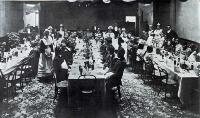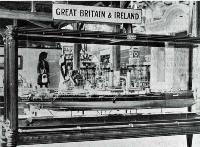The British Government Court
- The British Government Court, was "a representation of the traditions, history, art, science, and education of an imperial race".1
- The exhibits included educational and scientific material as well as items from the British Navy and Army.
Introduction
The British Government was enthusiastic about the Exhibition and contributed £10,000 towards the construction of an exhibit, which aimed to "reflect … the artistic, social, educational, scientific, and naval and military life of the British Isles".2 Captain Percy Atkin was appointed commissioner and John Eldon Gorst ,who had a long connection with the colony, was Britain’s popular and respected special envoy at the opening ceremony. The British Court occupied 23,760 square feet (2,210 square metres) of exhibition space and its various sections covered Education; Social Economy; Naval Life; Military Life; Medals, Coins and Seals; Geographical and Exploration; Meteorology; and, Photography.
Naval and Military exhibits
The first part of the Court was fittingly dedicated to the British Navy and Army, which formed the heart of the Empire.The naval and military exhibits were "reminders of Britain’s glorious feats of arms by land and sea … [which] typified all the virility, the fighting qualities of the Briton"3 and brought a "thrill of pride"4 to the sons of this distant post of Empire, whose minds in these days were filled with imperialistic thoughts. There were models of the battleships Swiftsure and Albion, drawings and plans for the New Zealand and photographs of a whole range of other vessels.
The Army exhibit included a complete mountain gun complete with "dummy" mules, which had been used in Northern India, other artillery including Maxim and Gardner guns and ammunition, uniforms and badges.
Education, Science and Study
A large portion of the exhibit dealt with the British educational system, and included examples of work from students at schools, universities, technical institutions and specialised agricultural, mining, music, nautical and other training organisations.
The Board of Trade, Post Office Savings Bank, London County Council and Metropolitan Asylums Board contributed diagrams dealing with social economic issues and the Royal Geographic Society a fine display of maps. There was a complete model weather station and a huge array of meteorological instruments from the British Meteorological Office, and a major collection of photographs provided by the Royal Photographic Society. Particularly popular were the works of Sir J. Benjamin Stone on old festivals, customs and ceremonies. The numismatics display included casts of the great seals of England from 790 to 1901, coronation medals and current coins.
![]()
Related photos
 Sir John Gorst banquets the Maoris |
 British Court |
 A Battleship model in the British Court |
Sources
- "The British Government’s Court: an Imperial display", Canterbury Times, 7 November 1906, page 28
- Cowan, J. Official record of the New Zealand International Exhibition of Arts and Industries held at Christchurch, 1906-7




